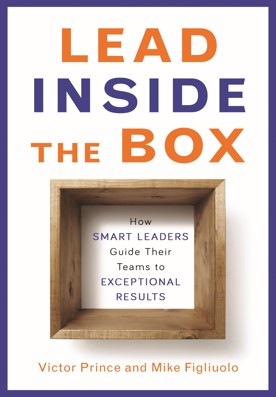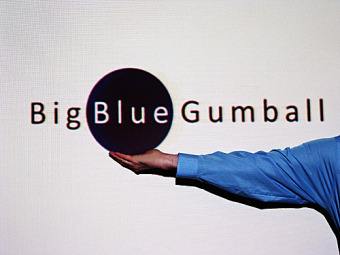 Todd Cherches | Comments Off |
Todd Cherches | Comments Off | Stop Enabling & Start Leading…By Leading Inside the Box
 Wednesday, July 15, 2015 at 2:10AM
Wednesday, July 15, 2015 at 2:10AM  I’m pleased to feature the following guest post by my friend Mike Figliuolo, co-author of the excellent brand new book Lead Inside the Box: How Smart Leaders Guide Their Teams to Exceptional Results. You can learn more about Mike and the book at the end of this post. Here’s Mike:
I’m pleased to feature the following guest post by my friend Mike Figliuolo, co-author of the excellent brand new book Lead Inside the Box: How Smart Leaders Guide Their Teams to Exceptional Results. You can learn more about Mike and the book at the end of this post. Here’s Mike:
Alan leads a team of highly-intelligent scientists. While most of their time is spent on scientific work, a portion of their roles is administrative. Before Alan took over the team, many of these scientists hadn’t been trained on these responsibilities because their previous leader tended to do all this administrative work himself. Alan fell into that same habit when he took over the team.
During a hectic period, Alan and I spoke about how stressed out he was. “I don’t have enough hours in the day to get all this stuff done.”
When I asked what he was working on, he shared that he was performing these administrative tasks himself. As I pressed him for an answer as to why he was doing this work instead of having his team members do it, he said “They’ve never been trained on it and they screw it up pretty often. I then have to fix those errors. When they do try to do it, they’re constantly in my office asking me for answers to the problems they need to solve. It’s more efficient for me to do the work myself rather than spend time I don’t have trying to train them on how to do it properly.”
I told him he was causing all the problems.
“Do you know what the problem is, Alan? You’re an enabler. Your behaviors are the root of the problem.” Needless to say he was surprised by my unsympathetic response to his plight. “What’s easier for them, Alan – to struggle with the work and suffer through the rework you’ll demand of them…or to claim they don’t have the skills and dump the work on your desk instead?”
Alan’s eyes widened with the painful realization of the dynamic he had created. I continued: “Here’s another thing to consider – how many hours have you spent doing this work over the last six months? And how much time would it take you to train them on these tasks so you didn’t have to spend the time doing them yourself?”
He knew he didn’t need to answer my questions.
I offered a final perspective. “I know they’re going to whine when you tell them to do the work. And they might even give you half-assed results in the hopes you’ll capitulate and do it yourself instead of holding them accountable for doing it again. You have to break this cycle. Short term, it will suck. They may not like you. You’ll be less efficient because you’ll be correcting more errors and spending more time training them than you would spend if you did the work yourself. Long term, we both know you need to make this shift.”
Alan stepped up to the challenge. When they brought him imperfect work, instead of picking up a black pen to do the work correctly for them, he reached for a red pen and marked the document up with the corrections he wanted them to make. He set a clear expectation that he would no longer be doing the work – they were only to come to him once they had a finished product. He made extensive correction marks on many deliverables. He listened to a great deal of groaning. He spent many hours teaching them how to do the work instead of doing the work for them.
After his team members concluded he wasn’t going to revert to old habits, they gave in and improved the quality of their work. For them, Alan made it more efficient to do the work right the first time rather than suffer through his red pen and additional hours of instruction on how to do things right.
After making this shift, Alan found he had more time available for working on higher priority projects. He delivered better work, spent more time thinking about strategic issues, and stepped into larger responsibilities which, in turn, advanced his career. His reallocation of his leadership capital enabled this transformation of the team dynamic from dysfunctional to effective.
Do you find you’re an enabler of bad behavior? If you want insights into how your behaviors drive your team members’ behaviors and how to lead them more effectively, take our Lead Inside the Box Assessment! This free tool will give you valuable insights into how to improve your team’s performance.

Mike Figliuolo is the co-author of Lead Inside the Box: How Smart Leaders Guide Their Teams to Exceptional Results and the author of One Piece of Paper: The Simple Approach to Powerful, Personal Leadership. He’s the managing director of thoughtLEADERS, LLC – a leadership development training firm. An Honor Graduate from West Point, he served in the U.S. Army as a combat arms officer. Before founding his own company, he was an assistant professor at Duke University, a consultant at McKinsey & Co., and an executive at Capital One and Scotts Miracle-Gro. He regularly writes about leadership on the thoughtLEADERS Blog.
*Bonus link from Todd: Click here to read my two-part thoughtLEADERS guest post on Mike’s site to find out the “10 Tough Questions Every Self-Aware Leader Needs to Be Able to Answer.”
 Todd Cherches | Comments Off |
Todd Cherches | Comments Off | 5 Myths About Millennials That Boomers and Gen Xers Need to Let Go
 Wednesday, July 15, 2015 at 1:54AM
Wednesday, July 15, 2015 at 1:54AM 
One of the hottest topics out there right now is the subject of generational differences in the workplace.
And there are a lot of myths -- and myth-conceptions -- floating around.
In this second in a series of posts co-written with generational expert Brad Szollose, this piece is directed towards Boomers and Gen Xers to help view the increasingly challenging Millennial situation with fresh eyes.
Click here to read the full piece.
 Todd Cherches | Comments Off |
Todd Cherches | Comments Off | Five Things Millennials Need to Know When Being Interviewed By a Baby Boomer
 Wednesday, July 15, 2015 at 1:47AM
Wednesday, July 15, 2015 at 1:47AM 
One of the hottest topics out there right now is the subject of generational differences in the workplace.
So how do we bridge this generational divide?
In this first in a series of posts co-written with generational expert Brad Szollose, this piece is directed towards Millennials to give them a few things to think about when dealing with Baby Boomers.
Click here to read the full piece.
 Todd Cherches | Comments Off |
Todd Cherches | Comments Off | Ice, Rice, or Mice? Six tips for avoiding miscommunication
 Thursday, June 4, 2015 at 1:34AM
Thursday, June 4, 2015 at 1:34AM 
My Diet Coke had gotten warm, so I asked the waitress for “some more ice.” A few minutes later, instead of the ice, she brought me another bowl of white rice.
I said “more ice”; she heard “more rice.” So whose fault was it? (And good thing I didn’t say “some ice”…or I might have ended up with “some mice”!)
It happens all the time: We say something that is crystal clear in our own mind, and yet the person on the receiving end hears something completely different. The ice vs. rice mix-up was a relatively low-cost, low stakes mistake (and, I actually wanted some more white rice anyway), but what if the stakes were higher?
What are the potential costs when an important job interview or work-related communication is lost in translation?
Please click here to read the rest of my post on LinkedIn.
 Todd Cherches | Comments Off |
Todd Cherches | Comments Off |  Communication,
Communication,  miscommunication,
miscommunication,  misunderstandings in
misunderstandings in  Communication
Communication What is “VisuaLeadership”® ?
 Wednesday, April 22, 2015 at 3:28AM
Wednesday, April 22, 2015 at 3:28AM
Our formula for success can best be summed up in the following simple equation:
VL = (VT + VC) x (M + L)
VisuaLeadership® = (Visual Thinking + Visual Communication) x (Management + Leadership)
VisuaLeadership® is the art and science of applying visual thinking and visual communication tools, tips, and techniques to more effectively manage and lead yourself and your people.
If a picture is worth a thousand words, and finding the right words takes time, and time is money, then wouldn’t it follow that business leaders would make more money – in less time – if they simply used more pictures to manage and to lead?
OK, it’s not quite that simple, but VisuaLeadershipR forever changes the way business professionals think, communicate, manage, and lead simply by leveraging the power of visual imagery, mental models, metaphors and analogies, storytelling, humor, and a whole range of other innovative, highly effective visual thinking and visual communication techniques.
In every workshop BigBlueGumball delivers -- whether the topic is management, leadership, team building, innnovation, or presentation skills -- we draw on our background and experience in the entertainment and media industries to meld art and science, words and pictures, stats and stories, and models and metaphors to Educate, Engage, and Excite.TM
The French novelist Marcel Proust wrote that “The real voyage of discovery consists not in seeking new lands, but in seeing with new eyes.”
Based on my 25 years of business experience, I've learned that as a management, leadership, and presentation skills consultant, trainer, executive coach, and educator, one of the most valuable contributions I can make to my clients' and my students' growth, development, and success is simply to help them see their world -- and envision their future -- with new eyes.
In our leadership workshops, when we ask participants to call out the first word that comes to mind when they hear the word, "leadership," most of them say, "Vision!" And when we ask them to define what we mean by "vision" in the context of leadership, it's all about having a mental image of the future: a picture, that they see in their "mind's eye" of an idealized future state that is different from -- and better than -- the current reality.
And, so, assisting and empowering leaders to turn that future vision into a new reality lies at the heart of what VisuaLeadership® is all about.
Dr. Martin Luther King Jr. (who I referred to as "The King of Visual Communication" in a previous blog post) did not famously say, "I have a 500-page strategic plan"; no, he said, simply, "I have a dream."
That speech is a classic example (probably THE classic example) of communicating a leadership vision.
And it's a perfect example of VisuaLeadership® in action.
*For more on what VisuaLeadership® is all about, please check out some of my other posts on this Gumblog and on my LinkedIn page, or feel free to get in touch anytime.
I'm currently working on my book entitled, VisuaLeadership: Leveraging the Power of Visual Thinking in Leadership and in Life, to be published in 2020 by Post Hill Press/Simon & Schuster. So stay tuned!
 Todd Cherches | Comments Off |
Todd Cherches | Comments Off | 
